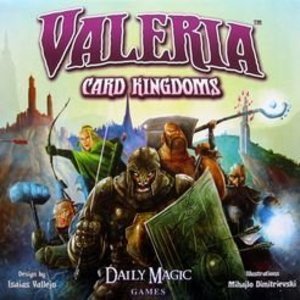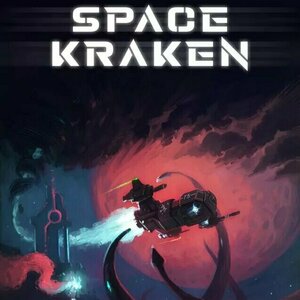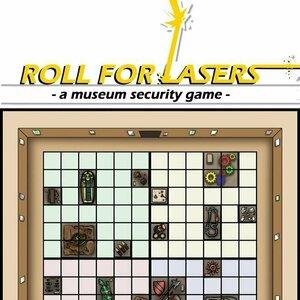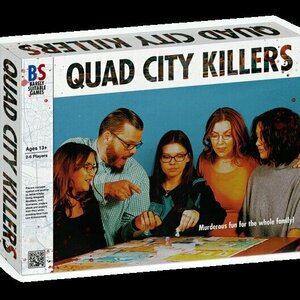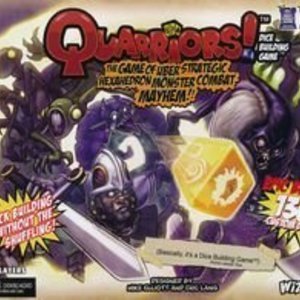Search
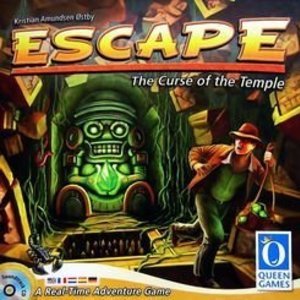
Escape: The Curse of the Temple
Tabletop Game
Escape: The Curse of the Temple is a cooperative game in which players must escape (yes...) from a...
Purple Phoenix Games (2266 KP) rated Valeria: Card Kingdoms in Tabletop Games
Jun 12, 2019
Imagine yourself a Duke/Duchess. You have land that needs to be developed. You have paltry starting resources and access to a Farmer to produce goods and a Knight to protect them. You need to build the greatest Dukedom/Duchy to prosper for generations and fend off the impending monster attack. In typical RPG fashion I ask you, “What. Do. You. Do?”
DISCLAIMER!! This review is for vanilla Valeria: Card Kingdoms. We have plans to add in the expansions in the near future. Once we do, we will add that information to this review or to a new review and link to it from here. -T
Okay, I have to admit, I Kickstarted Villages of Valeria (VoV) and Quests of Valeria (QoV) before picking up Valeria: Card Kingdoms (VCK). Why? Well, because I was wary of shared universe games at the time, so I tried one: Villages of Valeria. Dude, it’s a great game (review to come). When I Kickstart something I usually tend to go all-in. So I have the good stuff. Same with Quest for Valeria (review to come). I simply missed the boat on the first installment because I was late to the game.
Fast forward to me actually buying the game and trying it out. The mechanics felt very familiar (thanks Machi Koro), and the iconography was very familiar too (thanks VoV and QoV). But VCK excelled and rocked my world so much that I just cannot get enough of it.
Without paraphrasing the rulebook and teaching the entire game here, I’ll give a quick rules synopsis. You roll 2d6 on your turn and activate cards based on what you roll. Rolled a 3 and a 5? Ok, activate the 3 card. Also the 5 card. So far it sounds just like Machi Koro right? Here’s where it improves on MK. You also activate the 8 card (because 3+5=8). BUT ALSO EVERYONE ELSE ACTIVATES THEIR 3, 5, and 8 CARDS. Then you take two actions, which could be recruiting more citizen cards to activate when rolled, getting resources, defeating monsters, adding buildings to your Dukedom/Duchy. Most VP at the end of the game wins.
Roll dice, activate cards, take actions, win the game. It’s so simple, but yet so so so much fun. The game looks incredible when setup, there are a ton of card areas, monsters, the dice are big and chunky, game play is super fast, and you are always involved – even on your opponents’ turns. What more could you ask for? I’ll tell you: a super positive Purple Phoenix Games score of 22 / 24. It’s my favorite game of all time, after all.
https://purplephoenixgames.wordpress.com/2019/01/09/valeria-card-kingdoms-review/
DISCLAIMER!! This review is for vanilla Valeria: Card Kingdoms. We have plans to add in the expansions in the near future. Once we do, we will add that information to this review or to a new review and link to it from here. -T
Okay, I have to admit, I Kickstarted Villages of Valeria (VoV) and Quests of Valeria (QoV) before picking up Valeria: Card Kingdoms (VCK). Why? Well, because I was wary of shared universe games at the time, so I tried one: Villages of Valeria. Dude, it’s a great game (review to come). When I Kickstart something I usually tend to go all-in. So I have the good stuff. Same with Quest for Valeria (review to come). I simply missed the boat on the first installment because I was late to the game.
Fast forward to me actually buying the game and trying it out. The mechanics felt very familiar (thanks Machi Koro), and the iconography was very familiar too (thanks VoV and QoV). But VCK excelled and rocked my world so much that I just cannot get enough of it.
Without paraphrasing the rulebook and teaching the entire game here, I’ll give a quick rules synopsis. You roll 2d6 on your turn and activate cards based on what you roll. Rolled a 3 and a 5? Ok, activate the 3 card. Also the 5 card. So far it sounds just like Machi Koro right? Here’s where it improves on MK. You also activate the 8 card (because 3+5=8). BUT ALSO EVERYONE ELSE ACTIVATES THEIR 3, 5, and 8 CARDS. Then you take two actions, which could be recruiting more citizen cards to activate when rolled, getting resources, defeating monsters, adding buildings to your Dukedom/Duchy. Most VP at the end of the game wins.
Roll dice, activate cards, take actions, win the game. It’s so simple, but yet so so so much fun. The game looks incredible when setup, there are a ton of card areas, monsters, the dice are big and chunky, game play is super fast, and you are always involved – even on your opponents’ turns. What more could you ask for? I’ll tell you: a super positive Purple Phoenix Games score of 22 / 24. It’s my favorite game of all time, after all.
https://purplephoenixgames.wordpress.com/2019/01/09/valeria-card-kingdoms-review/
Purple Phoenix Games (2266 KP) rated Space Kraken in Tabletop Games
Jul 22, 2021
The overall story is not unfamiliar. Scientists create a genetically-modified creature to help solve a global problem, creature is somehow mutated through radioactive exposure, creature poses a threat to mankind, mankind must eliminate the creature. Now take that monster to space and BAM – we’ve got the origins on Space Kraken. Humanity has been forced to space in search of a new inhabitable planet. But alien races await you in the vast unknown, and the Space Kraken is always lurking…
Disclaimer: We were provided with a demo version of Space Kraken. The gameplay is that of the full version, just with a shorter storyline and fewer variations. What you see pictured below may not be identical to what will be received in the finalized version. Also, the game can be played solo or with multiple players – this preview will be covering the solo-only mode of play. I do not intend to cover the entire rulebook, but rather provide an overview of the mechanics and gameplay. -L
Space Kraken is a sci-fi dungeon crawler encompassed in a spiral-bound book. The only additional components you need are 2d6, 1d20, and a pencil with a decent eraser. To start a new game, you will first get set up for the campaign. There are 6 Flights (game modes) to choose from and you select one with which to play. Different Flights affect the start of game conditions, which will affect the overall gameplay. For example, one Flight might offer bonuses to your ability scores, while another could give you stronger weapons right from the start. Once you’ve selected your Flight, you will then set up your Story Lines. These will help dictate the story of your overall campaign, and will be influenced by your strategies and decisions along the way. From crucial plot points to opportunities for ‘side quests,’ the Story Lines work to drive the narrative. The next step is to create your crew. You choose 3 heroes to start with, and will ‘build’ them by giving them attributes, equipment, and skills. The specific parameters are detailed in the rules. After the crew is created, the game is officially ready to begin!
A game of Space Kraken is played over a series of turns, broken down into 5 phases. The first phase of a turn is to Activate Story Lines. These are tracked across a series of 4 tables of coordinates. Find the coordinate on the appropriate table for your Story Line, and proceed as necessary. Some coordinates link to Events that require you to make decisions, roll dice, execute commands, while other coordinates will just link to a new coordinate to be used next turn. Once you have Activated and resolved all your Story Lines for the turn, the game moves to the Ship Construction phase. At the start of the game, you will most likely skip this phase, but as the game progresses and you earn funds, you will be able to upgrade and modify your spaceship during this part of the turn.
The third phase of a turn is to Perform Your Own Action. You can choose to either: Initiate Space Flight, Land at an Already-Discovered Location, or Activate a Story Line Again. Initiating space flight gives you the opportunity to explore different regions of space, discover/explore new locations, and sometimes even engage in space combat. You could choose to land at an already-discovered location, which allows you to visit many of the ‘dungeons’. Or you can activate a story line again, which lets you advance one of your story lines forward. After you perform your own action, phase 4 begins – Quick Visit a Shop, Ammo Dealer, or Quest Master. This one is pretty self-explanatory. You can trade or purchase goods from locations you have visited, or you could visit the Quest Master for ‘side quests.’ And then finally the last turn phase is Quest Timer. Any quests you have that were not advanced in this turn get a mark for Lost Time – after 5 marks they are erased! So prioritize wisely when it comes to your quest completion. A new turn now begins, following the same phase structure as detailed above. The game continues until either you have defeated the Space Kraken, or your entire crew and/or ship has perished.
At first glance, Space Kraken is kind of daunting and intimidating. There’s a bit of a learning curve as you figure out this gameplay system before you can really dive in to play. That being said, once you understand how the different aspects work – Space Flight, Combat, Story Lines, Dungeon Exploration, etc. – it will all click together. This isn’t a game you just pick up and decide to play on a whim, it’s one that takes focus and dedication to complete a play-through. Just something to keep in mind! As with most campaign-style games, the question of replayability is always in the forefront, and I think that Space Kraken really handles it very well. The Story Lines alone offer a range of variability that ensures no two games will be the same. How you build your crew and ship could influence decisions made with regards to Story Lines, which in turn leads you down a unique path with a plethora of opportunities. The mechanic for generating new locations to explore (the dungeon crawling element) also provides a variety of places to explore, alien races to interact with, and physical elements like atmosphere. The chances for generating the exact same location more than once are pretty slim, I would say. All of these elements just add to the replayability of Space Kraken and keep it fresh and unique for each play-through.
Guiding the overall gameplay are your dice. Some Story Lines offer 2 solutions, and you will roll the dice to see with which one you end up. To generate a new location, you roll the dice a number of times, looking at the corresponding tables in order to build the map for your current foray into space. Obviously, combat, either in ships or on the ground, will use dice to help dictate the flow of battle and the outcomes of said fights. That is how you can get so much replayability from this game – dice rolling. The range of Story Lines and locations coupled with dice rolls really create a one-of-a-kind gameplay experience, no matter how many times you play through. You’ll never play the same game twice….well, unless your dice results are the exact same for every roll as they were the previous game.
Let’s touch on components for a minute. As stated above, this is only a demo version of the game. That being said, the game is encompassed in a spiral-bound book, and that is what the complete game will be like too. The only things you need to play besides the book are a couple of d6, a d20, and a pencil! I think it’s neat that so much gameplay can be packed into a single book. Between sessions if you’re not able to leave the book on your table, simply mark your page, fold everything back into the book, and you’re good to go! What do I mean by fold everything back into the book? Several of the pages in this game have fold-outs of additional materials to be pulled out when necessary. I really like that if you don’t currently need a page, it doesn’t need to be showing. It helps keep the game a little more focused, visually, in my opinion. My only complaint is that a couple of times, a fold-out section may overlap another fold-out section, meaning that you have to end up flipping pages anyway. A small price to pay for an all-in-one game book! My other qualm is that as you play, you will write in the book. After you complete a play-through, you can go back and play again – just erase everything and start over. My concern is that with repeated erasing on the pages, the quality will wear down and could be unusable after a certain number of plays. Maybe that’s not a problem for other gamers, but that is something that jumped into my head when playing this.
Overall thoughts? Space Kraken is pretty cool. There is a bit of a learning curve as you delve into the new system, but once you’ve got the general mechanics/gameplay down, the rest is pretty straight-forward. The fact that the entire game is encompassed in one book is a neat element too. It allows you to ‘save’ your progress and come back to it without the hassle of setting up a million components. Having only played the solo version of the game, I’m curious to see how the multiplayer side works, so that may just be my next play-through! If you’re in the market for a campaign-style game, without requiring tons of table space and eons of time to play through, consider checking out Space Kraken. It successfully funded on Kickstarter and the late pledges are now open!
Disclaimer: We were provided with a demo version of Space Kraken. The gameplay is that of the full version, just with a shorter storyline and fewer variations. What you see pictured below may not be identical to what will be received in the finalized version. Also, the game can be played solo or with multiple players – this preview will be covering the solo-only mode of play. I do not intend to cover the entire rulebook, but rather provide an overview of the mechanics and gameplay. -L
Space Kraken is a sci-fi dungeon crawler encompassed in a spiral-bound book. The only additional components you need are 2d6, 1d20, and a pencil with a decent eraser. To start a new game, you will first get set up for the campaign. There are 6 Flights (game modes) to choose from and you select one with which to play. Different Flights affect the start of game conditions, which will affect the overall gameplay. For example, one Flight might offer bonuses to your ability scores, while another could give you stronger weapons right from the start. Once you’ve selected your Flight, you will then set up your Story Lines. These will help dictate the story of your overall campaign, and will be influenced by your strategies and decisions along the way. From crucial plot points to opportunities for ‘side quests,’ the Story Lines work to drive the narrative. The next step is to create your crew. You choose 3 heroes to start with, and will ‘build’ them by giving them attributes, equipment, and skills. The specific parameters are detailed in the rules. After the crew is created, the game is officially ready to begin!
A game of Space Kraken is played over a series of turns, broken down into 5 phases. The first phase of a turn is to Activate Story Lines. These are tracked across a series of 4 tables of coordinates. Find the coordinate on the appropriate table for your Story Line, and proceed as necessary. Some coordinates link to Events that require you to make decisions, roll dice, execute commands, while other coordinates will just link to a new coordinate to be used next turn. Once you have Activated and resolved all your Story Lines for the turn, the game moves to the Ship Construction phase. At the start of the game, you will most likely skip this phase, but as the game progresses and you earn funds, you will be able to upgrade and modify your spaceship during this part of the turn.
The third phase of a turn is to Perform Your Own Action. You can choose to either: Initiate Space Flight, Land at an Already-Discovered Location, or Activate a Story Line Again. Initiating space flight gives you the opportunity to explore different regions of space, discover/explore new locations, and sometimes even engage in space combat. You could choose to land at an already-discovered location, which allows you to visit many of the ‘dungeons’. Or you can activate a story line again, which lets you advance one of your story lines forward. After you perform your own action, phase 4 begins – Quick Visit a Shop, Ammo Dealer, or Quest Master. This one is pretty self-explanatory. You can trade or purchase goods from locations you have visited, or you could visit the Quest Master for ‘side quests.’ And then finally the last turn phase is Quest Timer. Any quests you have that were not advanced in this turn get a mark for Lost Time – after 5 marks they are erased! So prioritize wisely when it comes to your quest completion. A new turn now begins, following the same phase structure as detailed above. The game continues until either you have defeated the Space Kraken, or your entire crew and/or ship has perished.
At first glance, Space Kraken is kind of daunting and intimidating. There’s a bit of a learning curve as you figure out this gameplay system before you can really dive in to play. That being said, once you understand how the different aspects work – Space Flight, Combat, Story Lines, Dungeon Exploration, etc. – it will all click together. This isn’t a game you just pick up and decide to play on a whim, it’s one that takes focus and dedication to complete a play-through. Just something to keep in mind! As with most campaign-style games, the question of replayability is always in the forefront, and I think that Space Kraken really handles it very well. The Story Lines alone offer a range of variability that ensures no two games will be the same. How you build your crew and ship could influence decisions made with regards to Story Lines, which in turn leads you down a unique path with a plethora of opportunities. The mechanic for generating new locations to explore (the dungeon crawling element) also provides a variety of places to explore, alien races to interact with, and physical elements like atmosphere. The chances for generating the exact same location more than once are pretty slim, I would say. All of these elements just add to the replayability of Space Kraken and keep it fresh and unique for each play-through.
Guiding the overall gameplay are your dice. Some Story Lines offer 2 solutions, and you will roll the dice to see with which one you end up. To generate a new location, you roll the dice a number of times, looking at the corresponding tables in order to build the map for your current foray into space. Obviously, combat, either in ships or on the ground, will use dice to help dictate the flow of battle and the outcomes of said fights. That is how you can get so much replayability from this game – dice rolling. The range of Story Lines and locations coupled with dice rolls really create a one-of-a-kind gameplay experience, no matter how many times you play through. You’ll never play the same game twice….well, unless your dice results are the exact same for every roll as they were the previous game.
Let’s touch on components for a minute. As stated above, this is only a demo version of the game. That being said, the game is encompassed in a spiral-bound book, and that is what the complete game will be like too. The only things you need to play besides the book are a couple of d6, a d20, and a pencil! I think it’s neat that so much gameplay can be packed into a single book. Between sessions if you’re not able to leave the book on your table, simply mark your page, fold everything back into the book, and you’re good to go! What do I mean by fold everything back into the book? Several of the pages in this game have fold-outs of additional materials to be pulled out when necessary. I really like that if you don’t currently need a page, it doesn’t need to be showing. It helps keep the game a little more focused, visually, in my opinion. My only complaint is that a couple of times, a fold-out section may overlap another fold-out section, meaning that you have to end up flipping pages anyway. A small price to pay for an all-in-one game book! My other qualm is that as you play, you will write in the book. After you complete a play-through, you can go back and play again – just erase everything and start over. My concern is that with repeated erasing on the pages, the quality will wear down and could be unusable after a certain number of plays. Maybe that’s not a problem for other gamers, but that is something that jumped into my head when playing this.
Overall thoughts? Space Kraken is pretty cool. There is a bit of a learning curve as you delve into the new system, but once you’ve got the general mechanics/gameplay down, the rest is pretty straight-forward. The fact that the entire game is encompassed in one book is a neat element too. It allows you to ‘save’ your progress and come back to it without the hassle of setting up a million components. Having only played the solo version of the game, I’m curious to see how the multiplayer side works, so that may just be my next play-through! If you’re in the market for a campaign-style game, without requiring tons of table space and eons of time to play through, consider checking out Space Kraken. It successfully funded on Kickstarter and the late pledges are now open!

King of Tokyo: Dark Edition
Tabletop Game
King of Tokyo: Dark Edition is a collector's edition of King of Tokyo, with the fight taking place...
BadgerMuffin (48 KP) rated Dungeons and Dragons in Tabletop Games
Jun 2, 2019 (Updated Jun 3, 2019)
Unlimited hours of Gameplay (2 more)
Multiple Expansion Books
Tonnes of Free Homebrew
The Greatest Ever Roleplaying Game? Damn Straight!
Dungeons and Dragons. A game released in 1974, 5 editions in and every time they out do themselves.
This game is fantastic for a number of reasons. Firstly, there are thousands of groups playing across the world, and this game is only getting more and more popular. This means, if you don't have any friends who want to play this, you can find a local group and join them, most of my closest friends I have met through DnD. Its perfect for anyone, most people are misfits and as such you form the closest bonds both in game and out of game.
I have now been playing DnD for the past two years straight, every Tuesday and Thursday; and yet I still haven't got bored. Every game is different, one week you're killing a dragon, the next week you're travelling across country with a Creepy Puppet Maker called Borris.
The leader of the group (AKA Dungeon Master) plans a rough idea of what is going to happen (it never does) and then as a group of players you walk around the world trying to accomplish quests. All of this is down to the fate of the dice. So no two games will ever be the same.
Honestly this is one of the games I will always return to and I plan on teaching my kids.
TL;DR
-Fun to Play.
-Available in most towns (and spreading across the country).
-Always different.
-Great to meet new people.
-Free Basic sourcebooks available from Wizards of the Coast
This game is fantastic for a number of reasons. Firstly, there are thousands of groups playing across the world, and this game is only getting more and more popular. This means, if you don't have any friends who want to play this, you can find a local group and join them, most of my closest friends I have met through DnD. Its perfect for anyone, most people are misfits and as such you form the closest bonds both in game and out of game.
I have now been playing DnD for the past two years straight, every Tuesday and Thursday; and yet I still haven't got bored. Every game is different, one week you're killing a dragon, the next week you're travelling across country with a Creepy Puppet Maker called Borris.
The leader of the group (AKA Dungeon Master) plans a rough idea of what is going to happen (it never does) and then as a group of players you walk around the world trying to accomplish quests. All of this is down to the fate of the dice. So no two games will ever be the same.
Honestly this is one of the games I will always return to and I plan on teaching my kids.
TL;DR
-Fun to Play.
-Available in most towns (and spreading across the country).
-Always different.
-Great to meet new people.
-Free Basic sourcebooks available from Wizards of the Coast
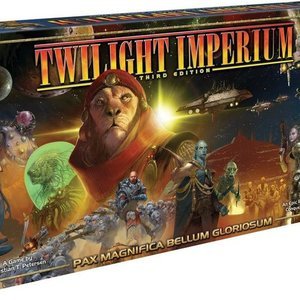
Twilight Imperium Third Edition
Tabletop Game
Twilight Imperium Third Edition is an epic empire-building game of interstellar conflict, trade, and...
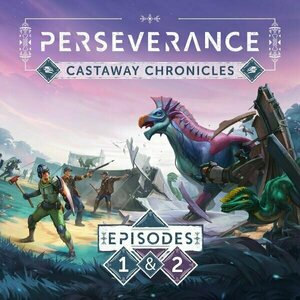
Perseverance: Castaway Chronicles
Tabletop Game
Caught in an enigmatic storm, a modern-day luxury ocean liner crashes ashore on an otherworldly...
Purple Phoenix Games (2266 KP) rated Roll for Lasers in Tabletop Games
Aug 3, 2020
Frickin’ lasers?! You made a game about frickin’ lasers? Yop. Well, WE didn’t, but Glass Shoe Games did. You’re a museum security company vying for the museum’s contract against other companies. The contract will go to the company who can arrange security lasers and mirrors in the most strategic locations to keep the museum’s collection safe. But also you will need to utilize the previous company’s placed mirrors and targets.
Roll for Lasers is a one-page roll and write game where the winner is the player whose company can hit placed targets more often (Victory Points) with lasers. Targets and mirrors will be placed all over the museum floor, so utilizing proper strategy, well-timed re-rolls, and special actions will see the winner awarded the security contract.
DISCLAIMER: We were provided a prototype copy of this game for the purposes of this review. These are preview copy components. Also, it is not my intention to detail every rule in the game, but to give our readers a general feel for how the game plays. You can back the game through the Kickstarter campaign launching August 4, 2020, order from your FLGS, or purchase through any retailers stocking it after fulfillment. -T
Setup for Roll for Lasers is simple. Give every player a pen (or erasable marker for laminated sheets) and 6d6. Decide as a group which three special actions to use for the game and you are ready to begin!
NOTE: Though I appreciate the USPS for everything they do, check out the picture below. I mean, come on. It didn’t hinder our play at all, but sheesh.
Play will commence in rounds. Each round will have three phases. The first phase is rolling for targets. Using the prescribed starting corner, players will roll all 6d6 and use these results to create x- and y-axis pairs to plot up to three targets in their mini grid. These are depicted by circles. The next phase is placing mirrors, and the players will again roll all 6d6 to be used to place up to three mirrors, depicted by diagonal lines. Finally, players will again roll all 6d6 to find either three singular dice or combinations of dice to fire a laser from the side or bottom of their grid in a straight line. For all targets the laser passes through, count 1VP. Each mirror encountered will alter the pathway of the laser, and by the end of the game lasers will be bouncing all over the museum. Play continues for three or four rounds (depending on player count) and once the last round ends, players count up VP to determine the winner!
Components. Again, we were provided a prototype copy of the game for this preview, and at this point I do not know what, if anything, will be changing as a result of a successful Kickstarter campaign. However, we were provided a nicely laminated sheet and a dry-erase marker to use. The sheet is laid out well, and the art is interesting without being in the way at all. Since Glass Shoe Games sent us an orange dry-erase marker (GREAT color choice btw) I borrowed the 6d6 from Roll Player because I knew I would find about a thousand d6 in that box. So components are minimal, and that’s quite all right with us this time.
Roll and write games are still popular now, and I, for one, am quite excited for that to be the case. I love being able to pull out a few dice, explain a few rules, and then get to playing. Roll for Lasers certainly delivers when I feel I have about 5-10 minutes to play something but still want a thinky experience. Rolling the dice and then determining which pair or combination of dice to use can get a little burdensome with AP-prone players, but being able to place the perfect mirror to foil an opponent, or adeptly using one of the special actions (like the triple-point target) is very rewarding. What I have also found with this is that all players are in the game until the very end. As you will see below, in my play against my wife I was behind for the first three rounds, but that last round was super robust for me and I finished way further ahead.
I love games that can be fun without having tons of components (I love games with tons of components too, don’t get me wrong), and Roll for Lasers is a great example of this. I have had a great time playing this every time, and can certainly see myself pulling this out a lot once game nights can safely return to normal. If you are missing a fast minimal roll and write for your collection with an interesting theme, consider backing or ordering Roll for Lasers.
Roll for Lasers is a one-page roll and write game where the winner is the player whose company can hit placed targets more often (Victory Points) with lasers. Targets and mirrors will be placed all over the museum floor, so utilizing proper strategy, well-timed re-rolls, and special actions will see the winner awarded the security contract.
DISCLAIMER: We were provided a prototype copy of this game for the purposes of this review. These are preview copy components. Also, it is not my intention to detail every rule in the game, but to give our readers a general feel for how the game plays. You can back the game through the Kickstarter campaign launching August 4, 2020, order from your FLGS, or purchase through any retailers stocking it after fulfillment. -T
Setup for Roll for Lasers is simple. Give every player a pen (or erasable marker for laminated sheets) and 6d6. Decide as a group which three special actions to use for the game and you are ready to begin!
NOTE: Though I appreciate the USPS for everything they do, check out the picture below. I mean, come on. It didn’t hinder our play at all, but sheesh.
Play will commence in rounds. Each round will have three phases. The first phase is rolling for targets. Using the prescribed starting corner, players will roll all 6d6 and use these results to create x- and y-axis pairs to plot up to three targets in their mini grid. These are depicted by circles. The next phase is placing mirrors, and the players will again roll all 6d6 to be used to place up to three mirrors, depicted by diagonal lines. Finally, players will again roll all 6d6 to find either three singular dice or combinations of dice to fire a laser from the side or bottom of their grid in a straight line. For all targets the laser passes through, count 1VP. Each mirror encountered will alter the pathway of the laser, and by the end of the game lasers will be bouncing all over the museum. Play continues for three or four rounds (depending on player count) and once the last round ends, players count up VP to determine the winner!
Components. Again, we were provided a prototype copy of the game for this preview, and at this point I do not know what, if anything, will be changing as a result of a successful Kickstarter campaign. However, we were provided a nicely laminated sheet and a dry-erase marker to use. The sheet is laid out well, and the art is interesting without being in the way at all. Since Glass Shoe Games sent us an orange dry-erase marker (GREAT color choice btw) I borrowed the 6d6 from Roll Player because I knew I would find about a thousand d6 in that box. So components are minimal, and that’s quite all right with us this time.
Roll and write games are still popular now, and I, for one, am quite excited for that to be the case. I love being able to pull out a few dice, explain a few rules, and then get to playing. Roll for Lasers certainly delivers when I feel I have about 5-10 minutes to play something but still want a thinky experience. Rolling the dice and then determining which pair or combination of dice to use can get a little burdensome with AP-prone players, but being able to place the perfect mirror to foil an opponent, or adeptly using one of the special actions (like the triple-point target) is very rewarding. What I have also found with this is that all players are in the game until the very end. As you will see below, in my play against my wife I was behind for the first three rounds, but that last round was super robust for me and I finished way further ahead.
I love games that can be fun without having tons of components (I love games with tons of components too, don’t get me wrong), and Roll for Lasers is a great example of this. I have had a great time playing this every time, and can certainly see myself pulling this out a lot once game nights can safely return to normal. If you are missing a fast minimal roll and write for your collection with an interesting theme, consider backing or ordering Roll for Lasers.
Purple Phoenix Games (2266 KP) rated Quad City Killers in Tabletop Games
Jan 30, 2021
So I am going to cut right to the chase here. I am from the Quad Cities, the area of Iowa and Illinois where the Mississippi River flows East-West instead of its normal North-South. Admittedly, the name given to the area is the Greater Quad City Area and includes around 18 actual towns and cities. I have a love for my hometown and defend it to all who think we are just cornfields and unexciting. That said, when I saw a game was being produced about serial killers roaming my own stomping grounds, I knew I had to preview it.
Quad City Killers (or QCK) is a competitive game of moving around a map and eliminating points of interest by using resources from hand. Or, in actual gamespeak, stalking the streets of the QC murdering prey by using weapons, modifiers, and scenario cards to adjust the winds of chance for success.
DISCLAIMER: We were provided a prototype copy of this game for the purposes of this review. These are preview copy components, and I do not know for sure if the final components will be any different from these shown. Also, it is not my intention to detail every rule in the game, as there are just too many. You are invited to download the rulebook, back the game through the Kickstarter campaign ending March 5, 2021, or through any retailers stocking it after fulfillment. -T
To setup place the large map (an actual map that you would find in your grandparents’ Oldsmobile) on the table. Shuffle the Prey deck and the Resources deck separately and place them in their spots on the map. Place the Heat tokens on the lowest space in each city. Keep the three dice nearby for all players’ use. Each player will choose a serial killer profile mat, a color of skull mover token, and Dexterity token to track progress. Each player will also draw five Resource cards from the deck and one Prey card to place on the board in a city along with their skull mover token. The game may now begin!
The first thing each player will do on their turn is perform a Hunt action by drawing and placing on the map the top card of the Prey deck. Most Prey are color-coded to be placed in a matching city, but some are not and may be placed in any city on the map. Next, the player may perform any three actions from the following: Hunt, Travel, Attack, Scenario, Discard.
Hunt works the same as the action performed at the beginning of each turn: draw a Prey card and place it on the board. In order to Travel to a new city the player will roll the dice. For a value of 1+ the player may travel to any city within their current state. For a value of 2+ the player may cross the Old Man to the other side (preferably using the half-finished under-construction new I-74 bridge). A player may play a Scenario card from their hand, and if it shows the Action icon they will spend one of their three actions to play and resolve it. A player may also choose to Discard two cards from their hand and replace them with cards drawn from the Resource deck for an action.
The game would not be named Quad City Killers if killing was not involved somehow. As the final option of action to be taken on a turn a player may choose to Attack a Prey card in the same city in which the player’s token resides. To Attack, the player will consult the Prey card’s printed defense value for their target number. The player will then combine any Resource cards they may have in hand with their current Dexterity score (tracked on their player mat) and the roll of the three dice. If the end result matches or exceeds the Prey’s defense value the Prey is eliminated. The player collects the Prey card for a trophy and for its Notoriety value (victory points) at game end.
Resource cards come in different flavors: Weapons, Scenarios, Modifiers, and Ego. Weapon cards are just that: weapons. They may be used once for an attempted kill and then are discarded. Scenarios may mess with opponent tactics, allow players to move Prey cards to different cities, or other various activities. Modifiers may also adjust the current Advantage enjoyed by the player or be played on a Prey card to lower its defense value. Ego cards (and also some Weapon cards) will have an M.O. icon on them and may be placed directly on the player mat. These M.O. cards offer a once-per-turn advantage for the player and are very powerful.
The game continues in this fashion of taking turns moving around the map, hunting prey and killing them, and using Resources to adjust the difficulty of the murder. Once a player has increased their Dexterity token to the end of the track the game ends and the players count up Notoriety values (VP) of all slain Prey cards to arrive at the greatest serial killer the Quad Cities has ever seen (which, being from the QC would be saying something – I don’t remember ANY serial killers here).
Components. Okay, this was a super cool game to open up in the mail. Inside the mailer box was this strange Evidence bag. I have never seen an Evidence bag in my life so I wasn’t quite sure what was inside. But when I opened it and saw it was the components for the game I immediately smiled at how cool that was to include. It certainly made an impression. Now, please remember that this is a prototype copy of the game, and the finished version will have slightly different and improved components. That said, what we were provided is very close to final quality (and better than some games I have in my collection!). The cards are all fine, the dice are dice, and the tokens are well-designed and interesting. The best component, for me, is the excellent map of the QCA. It folds/unfolds like an old map would (prior to GPS) and has my hometown right on it! Luckily I live in a suburb(?) of the Metropolitan QCA so my house is nowhere to be found on the map, but it is very strange and exciting to play a game on a map of your home.
The game as a whole is pretty good. Though the estimated time to finish the game is quoted at 90-180 minutes (and maybe with the full compliment of players), my plays with my wife were well under an hour each time. We both enjoyed the game quite a bit once we got over the whole premise of it. The theme is obviously dark and macabre, but in the end it is still just a game.
I felt very engaged for every second of the game as I watched my wife nail roll after roll during her Attack actions while I fail to manage even a roll of 2+. Yes, I am unable to roll 2+ on THREE DICE. My issues aside, the dice really do add a layer of chance (obv) that all the accounting and cardplay just will not cover. I like that. I like chance in my games, even when it goes against me. I also enjoyed having five actions from which to choose three on my turn, but I could also use the same action all three times if I wished. More options is usually good, and having more than one obvious route or strategy is a huge bonus for me.
All in all I really did enjoy this game quite a bit. Again, the theme may be off-putting for some, and I will not play this game with my children until they are probably older than the suggested 13+ but I can definitely see myself breaking this out with a group of adults who are itching for something completely different from what they are accustomed to playing. If you are like me and need something just absolutely jarring in your collection, I urge you to take a look at Quad City Killers, on Kickstarter now until March 5, 2021. Just stay out of Milan (pronounced MY-lin) and we will be fine.
Quad City Killers (or QCK) is a competitive game of moving around a map and eliminating points of interest by using resources from hand. Or, in actual gamespeak, stalking the streets of the QC murdering prey by using weapons, modifiers, and scenario cards to adjust the winds of chance for success.
DISCLAIMER: We were provided a prototype copy of this game for the purposes of this review. These are preview copy components, and I do not know for sure if the final components will be any different from these shown. Also, it is not my intention to detail every rule in the game, as there are just too many. You are invited to download the rulebook, back the game through the Kickstarter campaign ending March 5, 2021, or through any retailers stocking it after fulfillment. -T
To setup place the large map (an actual map that you would find in your grandparents’ Oldsmobile) on the table. Shuffle the Prey deck and the Resources deck separately and place them in their spots on the map. Place the Heat tokens on the lowest space in each city. Keep the three dice nearby for all players’ use. Each player will choose a serial killer profile mat, a color of skull mover token, and Dexterity token to track progress. Each player will also draw five Resource cards from the deck and one Prey card to place on the board in a city along with their skull mover token. The game may now begin!
The first thing each player will do on their turn is perform a Hunt action by drawing and placing on the map the top card of the Prey deck. Most Prey are color-coded to be placed in a matching city, but some are not and may be placed in any city on the map. Next, the player may perform any three actions from the following: Hunt, Travel, Attack, Scenario, Discard.
Hunt works the same as the action performed at the beginning of each turn: draw a Prey card and place it on the board. In order to Travel to a new city the player will roll the dice. For a value of 1+ the player may travel to any city within their current state. For a value of 2+ the player may cross the Old Man to the other side (preferably using the half-finished under-construction new I-74 bridge). A player may play a Scenario card from their hand, and if it shows the Action icon they will spend one of their three actions to play and resolve it. A player may also choose to Discard two cards from their hand and replace them with cards drawn from the Resource deck for an action.
The game would not be named Quad City Killers if killing was not involved somehow. As the final option of action to be taken on a turn a player may choose to Attack a Prey card in the same city in which the player’s token resides. To Attack, the player will consult the Prey card’s printed defense value for their target number. The player will then combine any Resource cards they may have in hand with their current Dexterity score (tracked on their player mat) and the roll of the three dice. If the end result matches or exceeds the Prey’s defense value the Prey is eliminated. The player collects the Prey card for a trophy and for its Notoriety value (victory points) at game end.
Resource cards come in different flavors: Weapons, Scenarios, Modifiers, and Ego. Weapon cards are just that: weapons. They may be used once for an attempted kill and then are discarded. Scenarios may mess with opponent tactics, allow players to move Prey cards to different cities, or other various activities. Modifiers may also adjust the current Advantage enjoyed by the player or be played on a Prey card to lower its defense value. Ego cards (and also some Weapon cards) will have an M.O. icon on them and may be placed directly on the player mat. These M.O. cards offer a once-per-turn advantage for the player and are very powerful.
The game continues in this fashion of taking turns moving around the map, hunting prey and killing them, and using Resources to adjust the difficulty of the murder. Once a player has increased their Dexterity token to the end of the track the game ends and the players count up Notoriety values (VP) of all slain Prey cards to arrive at the greatest serial killer the Quad Cities has ever seen (which, being from the QC would be saying something – I don’t remember ANY serial killers here).
Components. Okay, this was a super cool game to open up in the mail. Inside the mailer box was this strange Evidence bag. I have never seen an Evidence bag in my life so I wasn’t quite sure what was inside. But when I opened it and saw it was the components for the game I immediately smiled at how cool that was to include. It certainly made an impression. Now, please remember that this is a prototype copy of the game, and the finished version will have slightly different and improved components. That said, what we were provided is very close to final quality (and better than some games I have in my collection!). The cards are all fine, the dice are dice, and the tokens are well-designed and interesting. The best component, for me, is the excellent map of the QCA. It folds/unfolds like an old map would (prior to GPS) and has my hometown right on it! Luckily I live in a suburb(?) of the Metropolitan QCA so my house is nowhere to be found on the map, but it is very strange and exciting to play a game on a map of your home.
The game as a whole is pretty good. Though the estimated time to finish the game is quoted at 90-180 minutes (and maybe with the full compliment of players), my plays with my wife were well under an hour each time. We both enjoyed the game quite a bit once we got over the whole premise of it. The theme is obviously dark and macabre, but in the end it is still just a game.
I felt very engaged for every second of the game as I watched my wife nail roll after roll during her Attack actions while I fail to manage even a roll of 2+. Yes, I am unable to roll 2+ on THREE DICE. My issues aside, the dice really do add a layer of chance (obv) that all the accounting and cardplay just will not cover. I like that. I like chance in my games, even when it goes against me. I also enjoyed having five actions from which to choose three on my turn, but I could also use the same action all three times if I wished. More options is usually good, and having more than one obvious route or strategy is a huge bonus for me.
All in all I really did enjoy this game quite a bit. Again, the theme may be off-putting for some, and I will not play this game with my children until they are probably older than the suggested 13+ but I can definitely see myself breaking this out with a group of adults who are itching for something completely different from what they are accustomed to playing. If you are like me and need something just absolutely jarring in your collection, I urge you to take a look at Quad City Killers, on Kickstarter now until March 5, 2021. Just stay out of Milan (pronounced MY-lin) and we will be fine.
Lumos (380 KP) rated Quarriors! in Tabletop Games
Mar 19, 2018
A unique spin on the "deck builder". I like that instead of building a deck of cards, you are building a bag of dice. Each die has a different "spell" with a different power depending on how you roll. The game has the potential to be different every time you play, depending on the expansions you have. The fighting mechanic is well done and easy to maneuver. I would suggest using the "mat" included on the back of the instructions as sometimes it is hard to remember what has been spent and what is locked or on deck.
If you like to have complete sets of games and own all the expansions (like my friends and I do), it's good to know that the Light and Dark expansion doesn't really play well when mixed with the rest of the game. It does work as a stand alone though.
If you like to have complete sets of games and own all the expansions (like my friends and I do), it's good to know that the Light and Dark expansion doesn't really play well when mixed with the rest of the game. It does work as a stand alone though.
